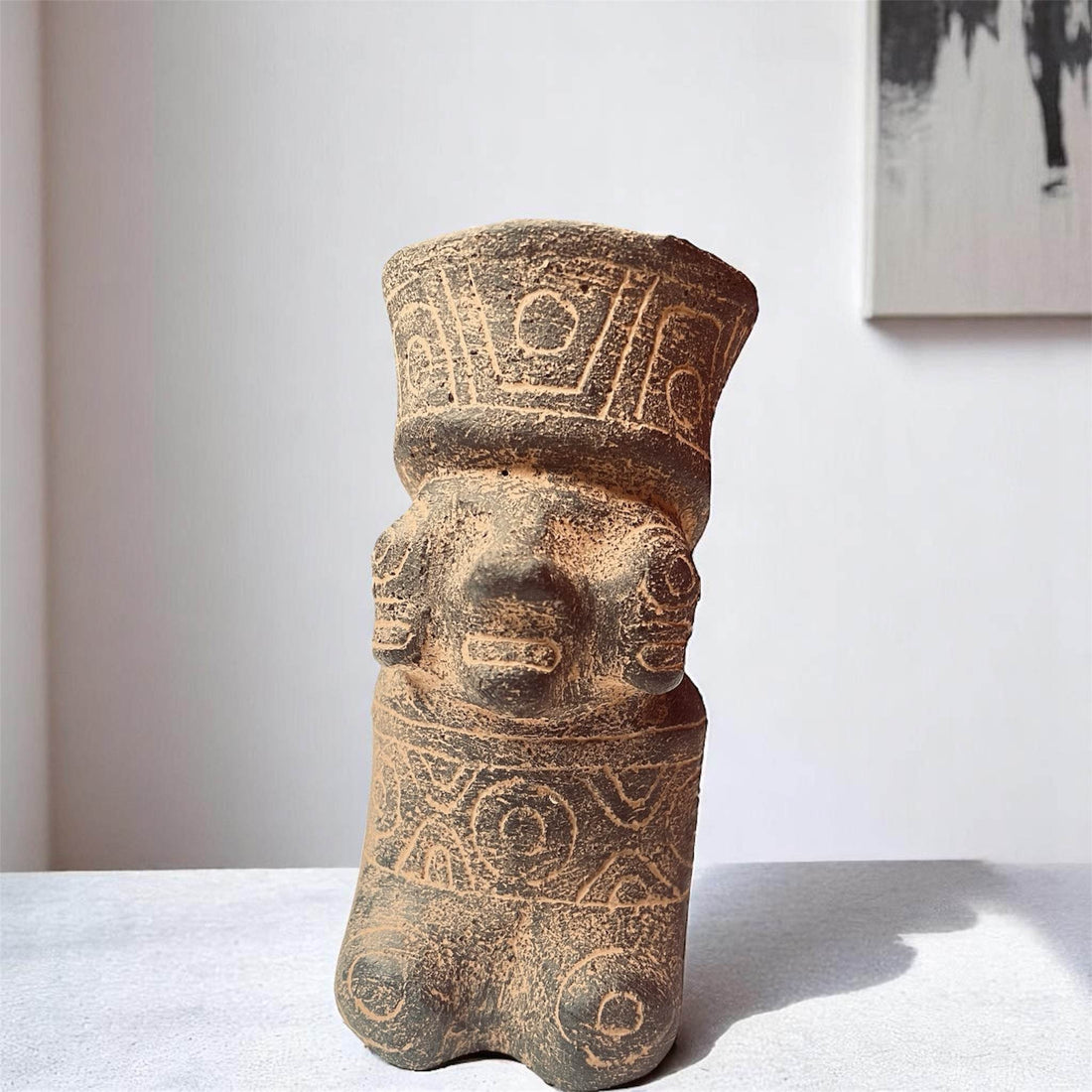
Ritual in Clay: The Tiwanaku Civilization and Its Ceremonial Legacy
Share
Who Were the Tiwanaku?
Long before the rise of the Inca Empire, the high-altitude plains surrounding Lake Titicaca were home to one of the Andes' most influential ancient civilizations: the Tiwanaku (also spelled Tiahuanaco). Flourishing between c. 400 and 1000 CE, Tiwanaku was not only a religious center but also a powerful regional force that shaped the spiritual and artistic traditions of the Central Andes for centuries.
Centered in what is now western Bolivia, the Tiwanaku capital was a planned ceremonial city with monumental architecture, including stepped platforms, sunken courts, and the famous Gateway of the Sun. Unlike later Andean empires, Tiwanaku exercised influence not through conquest, but through religious authority, pilgrimage networks, and the symbolic power of ritual objects and offerings.
What Happened to Tiwanaku?
By around 1000 CE, Tiwanaku began to decline, likely due to a combination of climate change (a prolonged drought), internal disruption, and the collapse of its religious-political model. Its ceremonial center was abandoned, but its visual language, religious symbolism, and ceremonial customs endured—especially in the Lake Titicaca region.
Rather than vanishing, Tiwanaku’s cultural memory was absorbed into later societies. Its imagery, including concentric circles, stepped motifs, and effigy vessels, remained embedded in Andean ritual life long after the city's fall.
Tiwanaku and the Inca: A Cultural Inheritance
By the time the Inca Empire rose in the 13th century, Tiwanaku was already a sacred ruin. Inca rulers treated the city as a place of ancestral pilgrimage. Some Inca even claimed lineage from Tiwanaku to legitimize their own power.
What the Inca learned and adopted from Tiwanaku included:
- Monumental stoneworking traditions
- Solar-aligned ceremonial planning
- Use of chicha (fermented maize beer) in state rituals
- Concepts of sacred geography and ancestor veneration
- Iconographic motifs, such as the staff-bearing deity and concentric-circle symbolism
The Inca transformed and centralized these ideas into imperial statecraft, but the roots were Tiwanakuan.
Religious Practices and Ritual Objects
Tiwanaku religion was complex, centered around:
- Solar worship (the sun as life-giver)
- Earth deities, especially linked to water, fertility, and agriculture — including Pachamama
- Ancestor veneration
- Ritual sacrifice, including camelids and offerings of chicha, coca, and textiles
- Sacred drinking — the ceremonial consumption of chicha was central to communal and elite rituals
These practices were mediated through ritual objects, including:
- Ceramic effigy vessels, often anthropomorphic and incised with geometric and cosmic symbols
- Libation bowls and keros
- Stone stelae representing deities, priests, or ancestors
- Burial offerings, including miniature tools, animals, and human figures
Ceramic vessels, in particular, were not merely functional — they embodied the ceremonial being, merging object and purpose into a symbolic whole.
Why This Matters Today
Artifacts made in the Tiwanaku tradition are more than objects — they’re survivors of a spiritual language that predates writing. When we encounter a vessel shaped in human form, engraved with sacred geometry, and blackened by age and ritual, we are touching the residue of cosmology.
Even in cases where precise dating is uncertain — such as pieces passed down through families or sourced outside excavation — the continuity of form and symbolism connects them to centuries of cultural transmission.
At From The Andes, our Bolivia ceramic effigy vessel represents that legacy. It is a singular piece — hand-formed, deeply symbolic, and rooted in the Tiwanaku visual tradition. Acquired in Bolivia and held in a private family collection since the 1970s, it carries not just form, but meaning.
Sources / Suggested Reading
- Young-Sánchez, Margaret. Tiwanaku: Ancestors of the Inca. Denver Art Museum.
- Stone, Rebecca. Art of the Andes. Thames & Hudson.
- Janusek, John Wayne. Identity and Power in the Ancient Andes. Routledge.
- Museo Nacional de Arqueología (La Paz, Bolivia)
- Lake Titicaca Pariti Island ceramic caches (Tiwanaku ritual vessels)
Explore the Artifact
View the Bolivia Ceramic Ritual Effigy Vessel — available now at From The Andes.
Glossary of Terms
Tiwanaku
An ancient Andean civilization that flourished around Lake Titicaca (in present-day Bolivia) between 400–1000 CE. Known for monumental stonework, ritual architecture, and symbolic art. Tiwanaku predates the Inca and heavily influenced their religious and artistic traditions.
Chicha
A traditional Andean fermented maize drink, often used in ceremonial contexts. Chicha was central to communal feasting and ritual libations in Tiwanaku and Inca cultures alike.
Effigy Vessel
A ceramic vessel formed in the shape of a human or animal figure, typically used for ritual offerings, libation, or burial. Effigy vessels were symbolic and often depicted spiritual or ancestral beings.
Pachamama
The Andean earth mother deity, associated with fertility, agriculture, and the cyclical nature of life. Ritual offerings (including chicha) were often made to Pachamama in Tiwanaku and later Inca traditions.
Akapana / Kalasasaya
Major ceremonial structures within the Tiwanaku archaeological complex. Akapana is a stepped platform mound; Kalasasaya is a large sunken temple aligned to astronomical events, underscoring Tiwanaku's cosmological focus.
